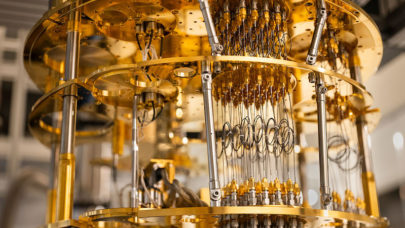March 23, 2023 — The QIR Alliance, an international effort to enhance platform interoperability and enhance the work of quantum computing developers, has announced a milestone in the industry-wide effort to accelerate adoption
 In 1952, facing opposition from scientists who disbelieved her thesis that computer programming could be made more useful by using English words, the mathematician and computer scientist Grace Hopper published her first paper on compilers and wrote a precursor to the modern compiler, the A-0, while working at Remington Rand.
In 1952, facing opposition from scientists who disbelieved her thesis that computer programming could be made more useful by using English words, the mathematician and computer scientist Grace Hopper published her first paper on compilers and wrote a precursor to the modern compiler, the A-0, while working at Remington Rand.
Over subsequent decades, the principles of compilers, whose task it is to translate between high level programming languages and machine code, took shape and new methods were introduced to support their optimization. One such innovation was the intermediate representation (IR), which was introduced to manage the complexity of the compilation process, enabling compilers to represent the program without loss of information, and to be broken up into modular phases and components.
This developmental path spawned the modern computer industry, with languages that work across hardware systems, middleware, firmware, operating systems, and software applications. It has also supported the emergence of the huge numbers of small businesses and professionals who make a living collaborating to solve problems using code that depends on compilers to control the underlying computing hardware.
Now, a similar story is unfolding in quantum computing. There are efforts around the world to make it simpler for engineers and developers across many sectors to take advantage of quantum computers by translating between high level coding languages and tools, and quantum circuits — the combinations of gates that run on quantum computers to generate solutions. Many of these efforts focus on hybrid quantum-classical workflows, which allow a problem to be solved by taking advantage of the strengths of different modes of computation, accessing central processing units (CPUs), graphical processing units (GPUs) and quantum processing units (QPUs) as needed.
Microsoft is a significant contributor to this burgeoning quantum ecosystem, providing access to multiple quantum computing systems through Azure Quantum, and a founding member of the QIR Alliance, a cross-industry effort to make quantum computing source code portable across different hardware systems and modalities and to make quantum computing more useful to engineers and developers. QIR offers an interoperable specification for quantum programs, including a hardware profile designed for Quantinuum’s H-Series quantum computers, and has the capacity to support cross-compiling quantum and classical workflows, encouraging hybrid use-cases.
As one of the largest integrated quantum computing companies in the world, Quantinuum was excited to become a QIR steering member alongside partners including Nvidia, Oak Ridge National Laboratory, Quantum Circuits Inc., and Rigetti Computing. Quantinuum supports multiple open-source eco-system tools including its own family of open-source software development kits and compilers, such as TKET for general purpose quantum computation and lambeq for quantum natural language processing.
Rapid Progress with KPMG and Microsoft
As founding members of QIR, Quantinuum recently worked with Microsoft Azure Quantum alongside KPMG on a project that involved Microsoft’s Q#, a stand-alone language offering a high level of abstraction and Quantinuum’s System Model H1, Powered by Honeywell. The Q# language has been designed for the specific needs of quantum computing and provides a high-level of abstraction enabling developers to seamlessly blend classical and quantum operations, significantly simplifying the design of hybrid algorithms.
KPMG’s quantum team wanted to translate an existing algorithm into Q#, and to take advantage of the unique and differentiating capabilities of Quantinuum’s H-series, particularly qubit reuse, mid-circuit measurement and all-to-all connectivity. System Model H1 is the first generation trapped-ion based quantum computer built using the quantum charge-coupled device (QCCD) architecture. KPMG accessed the H1-1 QPU with 20 fully connected qubits. H1-1 recently achieved a Quantum Volume of 32,768, demonstrating a new high-water mark for the industry in terms of computation power as measured by quantum volume.
Q# and QIR offered an abstraction from hardware specific instructions, allowing the KPMG team, led by Michael Egan, to make best use of the H-Series and take advantage of runtime support for measurement-conditioned program flow control, and classical calculations within runtime.
Nathan Rhodes of the KPMG team wrote a tutorial about the project to demonstrate how an algorithm writer would use the KPMG code step-by-step as well as the particular features of QIR, Q# and the H-series. It is the first time that code from a third party will be available for end users on Microsoft’s Azure portal.
Microsoft recently announced the roll-out of integrated quantum computing on Azure Quantum, an important milestone in Microsoft’s Hybrid Quantum Computing Architecture, which provides tighter integration between quantum and classical processing.
Fabrice Frachon, Principal PM Lead, Azure Quantum, described this new Azure Quantum capability as a key milestone to unlock a new generation of hybrid algorithms on the path to scaled quantum computing.
The Demonstration
The team ran an algorithm designed to solve an estimation problem, a promising use case for quantum computing, with potential application in fields including traffic flow, network optimization, energy generation, storage, and distribution, and to solve other infrastructure challenges. The iterative phase estimation algorithm1 was compiled into quantum circuits from code written in a Q# environment with the QIR toolset, producing a circuit with approximately 500 gates, including 111 2-Qubit gates, running across three qubits with one reused three times, and achieving a fidelity of 0.92. This is possible because of the high gate fidelity and the low SPAM error which enables qubit reuse.
The results compare favorably with the more standard Quantum Phase Estimation version described in “Quantum computation and quantum information,” by Michael A. Nielsen and Isaac Chuang.
Quantinuum’s H1 had five capabilities that were crucial to this project:
- Qubit reuse
- Mid-circuit measurement
- Bound loop (a restriction on how many times the system will do the iterative circuit)
- Classical computation
- Nested functions
The project emphasized the importance of companies experimenting with quantum computing, so they can identify any possible IT issues early on, understanding the development environment and how quantum computing integrates with current workflows and processes.
As the global quantum ecosystem continues to advance, collaborative efforts like QIR will play a crucial role in bringing together industrial partners seeking novel solutions to challenging problems, talented developers, engineers, and researchers, and quantum hardware and software companies, which will continue to add deep scientific and engineering knowledge and expertise.
Source: Quantinuum




























































